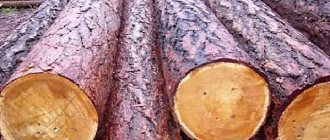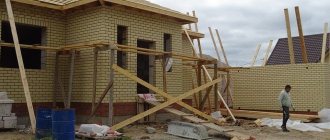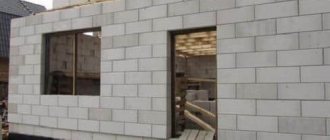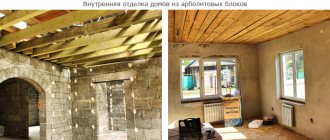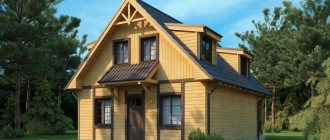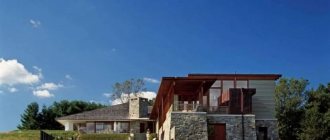In conditions of constant rise in energy prices, the need for building materials with high thermal characteristics is increasing. To reduce heat loss, modern projects are increasingly using aerated concrete and gas silicate blocks - materials of the class of thermal insulating cellular concrete. They are often confused due to their common properties and the same scope of application. Even specialists cannot always immediately tell a potential customer which material is in front of him - gas silicate or aerated concrete, which is better, what is the difference between them and whether there is any at all. Partly, the confusion is caused by the manufacturers themselves when they define aerated concrete as a type of gas silicate or vice versa.
In fact, differences exist and are expressed, first of all, by different compositions and methods of hardening (or setting) of solutions.
What is aerated concrete and gas silicate
These building materials are varieties of cellular concrete, which is characterized by a porous structure and low density. Durable and lightweight aerated concrete blocks have increased thermal insulation properties. The low thermal conductivity of cellular concrete is due to the presence of numerous voids filled with air.
Many people have a question about the difference between aerated concrete and gas silicate, what is the difference between them.
Both materials contain cement, sand, lime, gas-forming agents (aluminum paste or powder) and water. The difference is in the ratio of components and block manufacturing technologies.
Aerated concrete is a mixture whose main component is Portland cement. When the concrete mass, to which a gas-forming agent is added, hardens, spherical voids with a diameter of 1-3 mm are formed in it. The reason for their appearance is the release of hydrogen during a chemical reaction between aluminum and lime.
The composition of aerated concrete includes:
- Portland cement – 50-70%;
- Sand – 20-40%;
- Lime – 1-5%;
- Gas-forming agent – 0.04-0.09%;
- Water – 0.25-0.8%.
Construction of a house from aerated concrete blocks Source stroitelstvo-remont-sochi.ru
Gas silicate has a lime-silica binder base, consisting of silicate sand (up to 60%) and lime (24%). Aluminum powder or paste is also added to form cells.
Due to the difference in the content of cement and lime, products made from these materials differ in color. Aerated concrete blocks have a gray tint, while gas silicate blocks are white.
Construction of a wall from gas silicate Source blockexpert.ru
Production technology
The main raw material from which aerated concrete is made is an aqueous solution of cement (Portland cement) with the addition of lime and sand.
Gas silicate is cellular silicate concrete consisting of a mixture of sand and lime in a ratio of 0.62:0.24.
The thermal insulation properties of gas blocks are due to their porous structure, which is formed as a result of swelling of working mixtures with special blowing agents (usually aluminum powder or paste). In the finished product, voids are bubbles with a diameter of 1-3 mm, occupying 70–90% of the total volume of the material. They are filled with air, which, due to low thermal conductivity, acts as a thermal insulation layer. In high-quality blocks, the pores are distributed as evenly as possible.
As for hardening methods, the main thing that significantly distinguishes cellular gas silicate from aerated concrete is the mandatory heat treatment with steam in an autoclave at a temperature of 180 - 200˚C and a pressure of 8 to 14 atmospheres. Aerated concrete can be autoclaved or air cured.
Autoclave processing significantly accelerates the setting of the material, increases its strength, ensures stability of the geometric shape and minimal shrinkage during operation.
Externally, finished products are distinguished by color: gas silicate or autoclaved aerated concrete is almost white, gray color is typical for non-autoclaved aerated concrete.
Technologies for manufacturing blocks from aerated concrete and gas silicate
To understand the difference between aerated concrete and gas silicate, it is necessary to take into account the difference in the methods of manufacturing such materials.
To obtain cellular concrete, 2 technologies are used: autoclave and non-autoclave.
In the non-autoclave production of porous blocks, solidification of the mass after adding a gas-forming agent occurs under natural conditions, without additional processing. It takes 28 days for the concrete to completely harden.
Autoclave technology allows you to speed up this process up to 12-15 hours by maintaining the concrete mass under a pressure of 8-14 atm at temperatures up to 175-190˚C.
The advantages of autoclave technology are:
- Possibility of giving gas blocks an exact geometric shape and standard dimensions;
- More uniform distribution of voids, enhancing heat and sound insulation;
- Increasing the hardness of blocks, reducing the likelihood of shrinkage and cracking of the material.
Warning! A significant disadvantage is the increased fragility of blocks processed in an autoclave. Special care is required when transporting and stacking them. To secure heavy objects on walls made of autoclaved aerated concrete, only anchor bolts with special spacers are suitable.
Reliable fastenings for aerated concrete walls Source eyecorrector.ru
The advantages of non-autoclave blocks are lower hygroscopicity and lower price.
Aerated concrete is made using both methods.
For the production of gas silicate, only autoclave technology is used.
See also: Catalog of companies that specialize in the construction of aerated concrete houses
External difference
An unprepared person, seeing similar building materials nearby for the first time, will not be able to give an exact answer as to where the gas silicate block is and where the aerated concrete block is. But they have their own visual differences, which are determined by their composition and production technology. For example, Portland cement is not used in the manufacturing process of silicate products. But in the creation of aerated concrete it is needed, since it is its binding element. This factor affects the color of the products, which is the external difference between gas silicate blocks and aerated concrete:
- So, the first ones are created using the autoclave method and contain a large amount of lime, due to which they have a white color;
- In the second products, the acquisition of characteristics occurs under conditions of natural hardening using Portland cement, which gives them a gray tint.
Due to changes in the amount of binder in materials, their color deviates from other similar products. Thus, with an increase/decrease in the cement content in aerated concrete, its color can vary, ranging from dark gray to light gray. But for silicate options, the color scheme starts with bright white and ends with a grayish-white color. In addition, the difference between similar building materials lies in the different level of hygroscopicity:
- Gas silicate at high humidity absorbs it faster, because when a sharp temperature change occurs, this leads to a violation of the integrity of the blocks;
- It is more difficult for liquids to get into aerated concrete products, which is due to the closed air pores. Thanks to this, such materials have good strength and moisture resistance.
Such blocks require finishing due to their porous outer surface. To create comfortable conditions in the premises with their help, it is necessary to carry out proper external and internal decoration.
General advantages and disadvantages of aerated concrete and gas silicate
Aerated concrete or gas silicate have the same structure, due to which they have the following common advantages:
- Low thermal conductivity coefficient - from 0.09 W/m˟С (For comparison, it can be noted that for brick this figure is 0.5-0.8 W/m˟С).
- Good frost resistance (50 or more defrosting cycles).
- Lightness, strength, environmental friendliness, fire safety.
- Ease of processing blocks (cutting, grinding). A saw is used to cut aerated concrete and gas silicate.
Cutting aerated concrete blocks using a saw Source mtdata.ru
- Rapid formation of masonry.
Common disadvantages of aerated concrete and gas silicate are:
- The ability of porous blocks to absorb moisture well, the need to use special coatings to protect walls from dampness.
- Increased risk of damage to aerated blocks during transportation, storage and laying of walls.
- Possibility of shrinkage of materials by 1-3 mm as they dry. This process leads to a decrease in the strength of the masonry, the formation of cracks in the walls and the destruction of the plaster.
- Poor adhesion of concrete to binding materials used in creating masonry and finishing walls made of aerated blocks. There is a need to use adhesives with increased adhesion.
Damaged gas silicate blocks Source ytimg.com
Advantages of gas silicate
This type of building blocks is popular. It is produced by using lime as the main binding element and is processed using the autoclave method. Its advantages include the following properties
- Strength. Thanks to the technology of creating blocks, air bubbles are evenly distributed throughout the entire volume, which allows the gas silicate to have high strength properties. It is less prone to cracks and shrinkage.
Given the same density indicators, aerated silicate products have a strength level 1.5 times greater than aerated concrete.
- Noise insulation. Due to the presence of an increased number of pores inside the materials, it has good noise insulation properties;
- Specific gravity. Due to the smaller mass of such blocks, their use requires less requirements for the bearing capacity of the foundation. This makes it possible to reduce the cost of construction when using them;
- Block shape. Due to the fact that after autoclave processing the material is cut to obtain the required dimensions, permissible deviations do not exceed 3 mm;
- Aesthetics. Buildings constructed from white gas silicate have a more attractive appearance.
Comparison of the properties of aerated concrete and gas silicate
When figuring out how aerated concrete differs from aerated silicate and what is better to use in the construction of various objects, it is necessary to compare the technical characteristics of these materials.
| Specifications | Aerated concrete | Gas silicate |
| Density, kg/cubic. m | 300-1200 | 300-1200 |
| Thermal conductivity, W/m˟S | 0,09-0,35 | 0,11-0,16 |
| Frost resistance (number of freeze-thaw cycles) | 25-75 | 25-150 |
| Shrinkage, mm/sq. m | 0,5 | 0,3 |
| Moisture absorption (% by weight of material) | 16-25 | 25-30 |
| Compressive strength, MPa | 1,5-2,5 | 1-5 |
| Compressive strength, MPa | 40 | 30 |
| Compressive strength, MPa | 190-250 | 190-250 |
Size and weight
The size of the gas silicate block depends on the type of material and its manufacturer. The most common dimensions are expressed in millimeters:
- 600x100x300;
- 600x200x300;
- 500x200x300;
- 250x400x600;
- 250x250x600.
Due to its cellular structure, gas silicate is a fairly light material. The weight of porous products differs according to the density of the material and its size:
- D400 – from 10 to 21 kg;
- D500-D600 – from 9 to 30 kg;
- D700 – from 10 to 40 kg.
The small mass of the blocks and the ability to select the required size greatly facilitates the construction process.
Features of the use of aerated concrete and gas silicate blocks
When figuring out which is better - gas silicate or aerated concrete, and what is the difference between these substances, it is important to understand the features of their use. In this case, it is necessary to take into account not so much the difference in composition as the correct use of materials.
- For laying blocks of aerated concrete and gas silicate, a special adhesive mixture is used, which, in addition to cement and sand, contains additives that improve adhesion and accelerate the setting of the binder mortar;
- Considering the increased hygroscopicity of cellular concrete, façade walls made of aerated concrete must be plastered, covered with a layer of moisture-proofing putty, or other means used to protect external walls from precipitation. To make them less wet by rain, it is necessary to install an overhanging roof;
Original decoration of aerated concrete walls with bricks and porcelain tiles Source expertfasada.ru
- For insulation, painting or finishing of facades, it is necessary to use materials with good vapor permeability. At the same time, moisture will not be retained in the concrete blocks and the walls will not mold;
Some features of working with gas blocks
When working with both aerated concrete and gas silicate, you must adhere to the following recommendations:
- Penetration of moisture into the pores reduces the thermal insulation properties of the material. Therefore, facades must be protected from precipitation using external finishing materials intended for aerated concrete or gas silicate - plaster, facade paints, curtain siding, cladding, thin-layer putty. When finishing facades with facing bricks, a ventilation gap of 30–40 cm should be provided. Additional protection will be provided by an increased roof overhang.
Note! Any finishing materials must have good vapor permeability or ventilation. The vapor permeability of insulation, plaster, and paint should be higher than the vapor permeability of the wall material. It is better to install additional insulation using mineral wool.
Important! When using multi-layer finishing and insulation, it is important to adhere to the rule: the vapor permeability in each layer should be higher than in the previous one. Otherwise, condensation will inevitably accumulate and mold will appear.
- Fastening of hanging furniture made of aerated concrete or gas silicate is done using fasteners with dowels. There are special anchor bolts for gas blocks.
- Despite the relatively low weight of gas-block building materials, you should not skimp on the dimensions of the foundation.
- A layer of waterproofing must be laid under aerated concrete and gas silicate structures.
- To protect walls from cracking during shrinkage, masonry reinforcement and expansion joints must be performed. The first row and every fourth row, as well as window openings, are reinforced.
Video description
About whether it is possible to do without insulating walls made of aerated concrete - in the following video:
- Under aerated concrete and gas silicate blocks, waterproofing material must be laid on the foundation;
- To prevent shrinkage and destruction of the walls, during the laying of the blocks, reinforcement is made in the first and every fourth row, as well as in the area of window openings.
Reinforcement of a load-bearing wall during the construction of a house made of aerated concrete Source zaggo.ru
Autoclaved or non-autoclaved aerated concrete?
Let's return to autoclaves. What is this design like?
This is a reservoir in which the material hardens at high pressure and temperature. Thus, it becomes much denser than it was before.
The material processed using this tank has a uniform structure and white color.
Non-autoclaved aerated concrete, in turn, is often made at home (garage). Because of this, the surface geometry suffers, and the structure turns out completely uneven. These nuances negatively affect the quality of the gas block. The only advantage of non-autoclaved aerated concrete is its low cost. But is it worth it? Even if the manufacturer adds fiber, this is not a guarantee that cracks will not appear in the walls over time.
Briefly about the main thing
When choosing competitive materials for the construction of low-rise and high-rise buildings, customers often have doubts: “gas silicate blocks or aerated concrete blocks - which is better, which are more suitable.
People compare the advantages and disadvantages of materials and focus on their technical characteristics. Take into account that gas silicate blocks are manufactured only in a factory manner and have more precise dimensions and shape.
Gas silicate has other advantages over aerated concrete (better heat and sound insulation, less hygroscopicity and shrinkage). However, price plays an important role.
Construction of objects from aerated concrete is cheaper. Considering that the difference in quality indicators is insignificant, many people prefer to buy aerated concrete blocks.
When purchasing materials, it is especially important to take into account building codes and recommendations of specialists.
Ratings 0
What to look for when purchasing
Let's list the main points.
- Geometry. Extremely important for future construction. The laying is carried out on a thin layer of glue, the thickness of which may not be enough to smooth out irregularities. You will have to either increase the thickness of the adhesive composition, which is not good, or trim off the protruding parts, which will significantly complicate and lengthen the construction process. Well, indirectly, even blocks are a sign of solid production.
- Density of the material. The denser the blocks, the stronger they are. And more expensive, by the way. However, do not forget that an increase in strength entails a decrease in thermal insulation qualities. Therefore, with cellular building materials, as a rule, it is better to play it safe and choose the most durable one, which does not work very well. We need a middle ground: strong enough and good thermal insulation.
- Size and type. It is especially important if you plan to lay the masonry yourself, to choose a size that is comfortable for you. And it will be decided whether these will be ordinary blocks or tongue-and-groove ones.
- Manufacturer. Big companies don't cut corners. For little-known brands, stricter checks and controls are required.
Array structure
Gas silicate and aerated concrete have another distinctive feature - hygroscopicity. The increased hygroscopicity of gas silicate contributes to the saturation of the concrete mass with moisture, which promotes the gradual destruction of concrete under the influence of temperature changes. Aerated concrete has increased resistance to moisture absorption and has a more durable structure of the concrete mass. It is easy to conduct an experiment by immersing each of these materials in water.
Despite the varying degrees of hygroscopicity, the blocks require protection of the cellular surface with plaster. Premises built from cellular concrete provide a comfortable temperature regime and a microclimate favorable for living.

